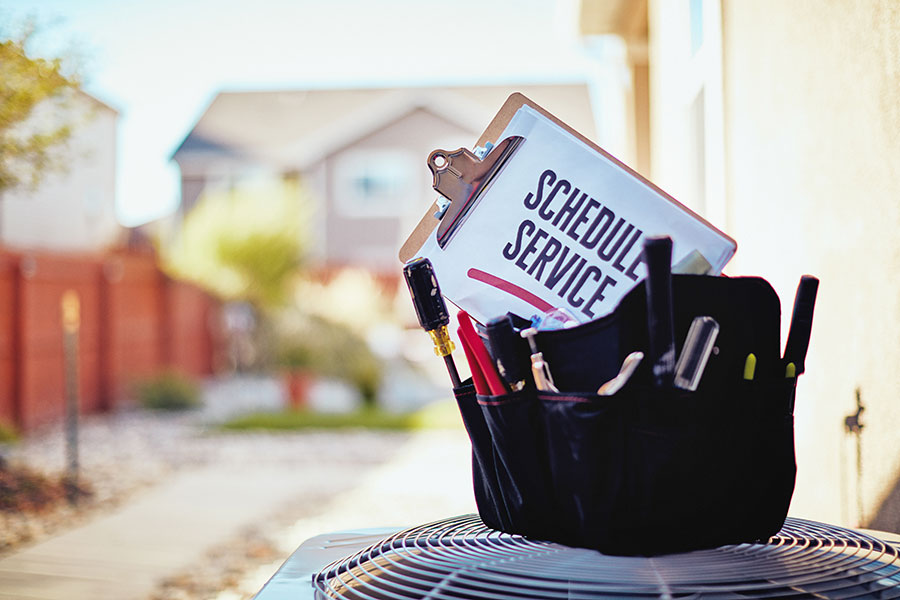Spring HVAC and Air Conditioning Unit Maintenance Checklist
Winter’s winding down and spring is upon us again. Spring usually doesn’t demand too much of your HVAC, so it’s a great time to get a jump on your AC maintenance checklist. That way, you can make sure your system is tip-top when you need it for comfort during the warmer temps in areas such as Aurora, Oswego, Plano, Plainfield and Montgomery.
We’ve put together important things you can do to help maintain the life and performance of your air conditioning unit this season. While certain steps are best done by a professional, you can do several things yourself. Be sure to make note of them.

Here we go:
2020 Spring Maintenance Checklist
▢ Change the air filter. If you haven’t already replaced it, the filter is probably ready for a switch after working to heat your home or office all winter. A clean filter’s impact can be instant by helping maintain proper airflow, which keeps your unit from having to work too hard to cool your spaces. That in turn also helps you control your energy bills. Remember to change the filter again every one to three months as well.
▢ Tighten electrical connections. This is important because bad connections can make operating your AC unsafe. They can also shorten the life of your unit’s main components.
▢ Check the operation of your thermostat and AC unit. Activate your AC to ensure it starts, runs and shuts off properly. If it is not cooling your spaces at the temperature you set, you might have an issue with the thermostat or another system component. Also pay attention to any unusual noises or smells.
▢ Clean and lubricate indoor HVAC components. This includes the blower fans and coils. Keeping these parts clean and lubricated will help ensure they work efficiently (e.g. less friction and electricity usage), as well as help prevent possible problems later.
▢ Clean the outdoor air conditioning unit. Clear away any grass, dirt or leaves that might be blocking vents. This will contribute to better airflow. Airflow problems can reduce system efficiency by up to 15%!
▢ Check the AC’s refrigerant. To keep your spaces cool when the temperatures rise, your system needs the right amount of refrigerant. Inspect the current level. If it is low, check for a leak as well before adding refrigerant.
▢ Clean the evaporator coil. You’ll typically locate the coil behind a door panel or above the blower motor. It is typically made in an A shape and covered with thin sheets of metal referred to as fins. Start by removing any outer dust with a soft brush. Next, spray the coil with coil cleaner (available at many local home improvement stores). Let the cleaner drip into the pan beneath the coil. Lastly, clean the pan and verify the drain flows freely.
▢ Clean the evaporator drain line. The evaporator coil absorbs heat from moist, warm air that travels through it. It then cools it and circulates it back into your spaces. This can create humidity that forms condensation on the coil that then falls into the drip pan. The drain line (or tube) carries that water away. If mold or algae build in the line, it can form a blockage that affects indoor humidity or even causes water damage. You can clean the drain line with a wet or dry vac, a plumbing snake or a garden hose. You can also pour distilled white vinegar through the line.
▢ Turn off the water supply to the humidifier. Because the evaporator coil creates humidity near it, consider turning off the water to the humidifier during the summer. Some humidifiers have a “summer” setting that lets you simply turn a knob to deactivate the unit for the season.
▢ Clean the outdoor condenser unit and the area around it. To clean the unit, take off the outer cover or grate that covers it. A basic shop vac will help with removing any debris outside the unit. To clean inside the condenser, use a garden hose to spray the fins. Also clear away any debris such as dirt, sticks, leaves and grass that may have gathered around the base of the condenser during the winter. Trim vegetation and branches to be at least two feet from the unit as well.
A few other maintenance steps include:
- level the condenser unit
- inspect and straighten the fins
- check the compressor and outdoor fan motor
- replace any worn belts, parts or connections
Here When You Need Inspections or Maintenance
As we discussed, you might be able to perform some of the measures on your Spring HVAC and Air Conditioning Unit Maintenance Checklist yourself. If you ever need support with others, the technicians at Beery Heating and Cooling will be glad to assist you.
We can also provide periodic follow-up inspections for ideal system performance in areas such as Naperville, Batavia, Bolingbrook and Lombard. A little maintenance now goes a long way later! Call us anytime at (630) 585-6444.
